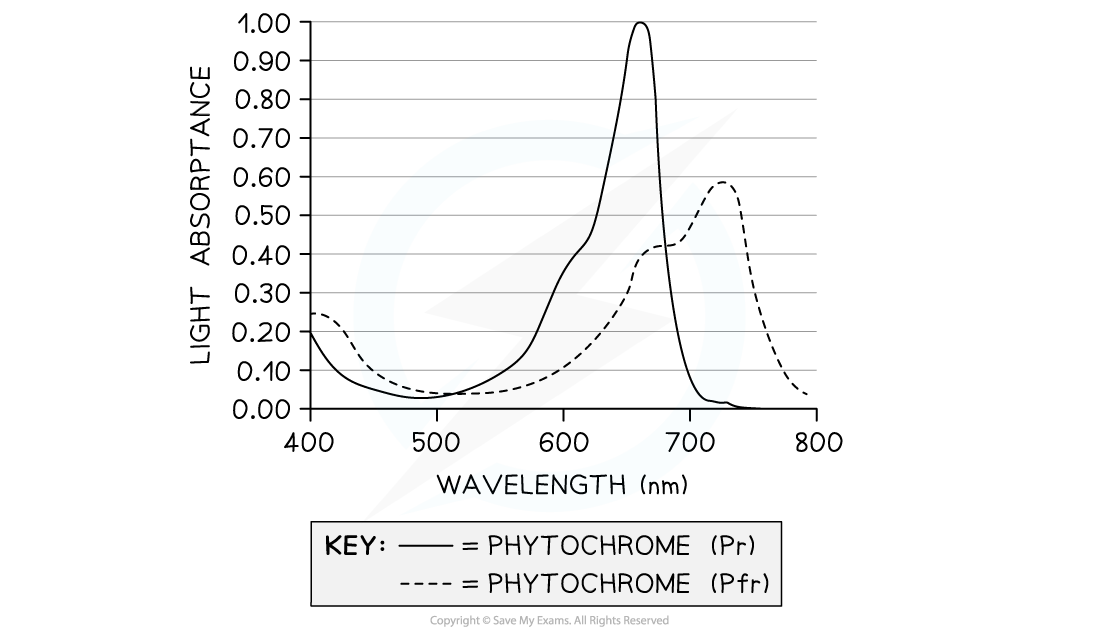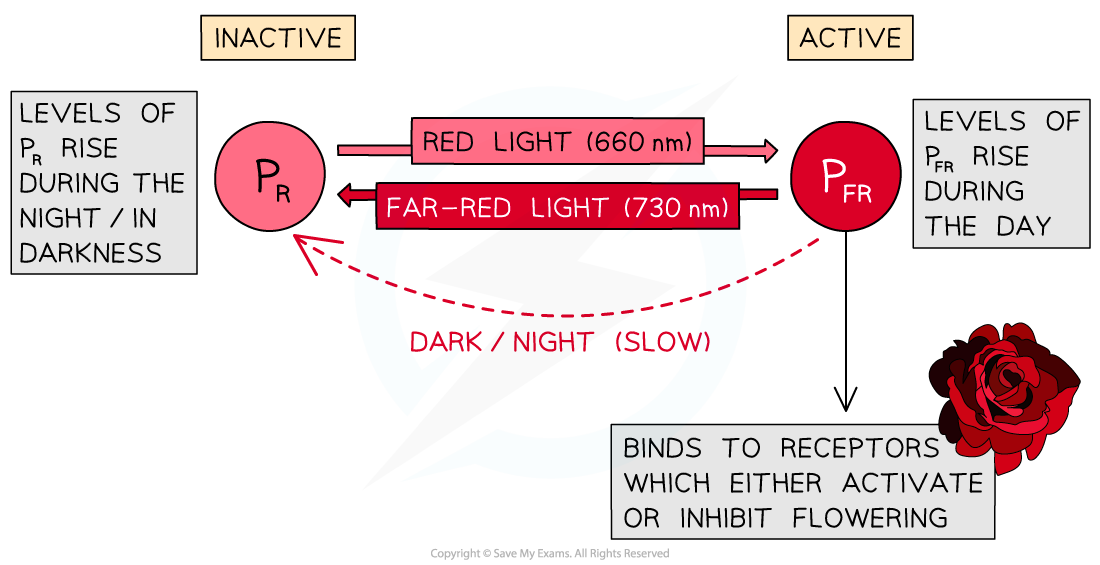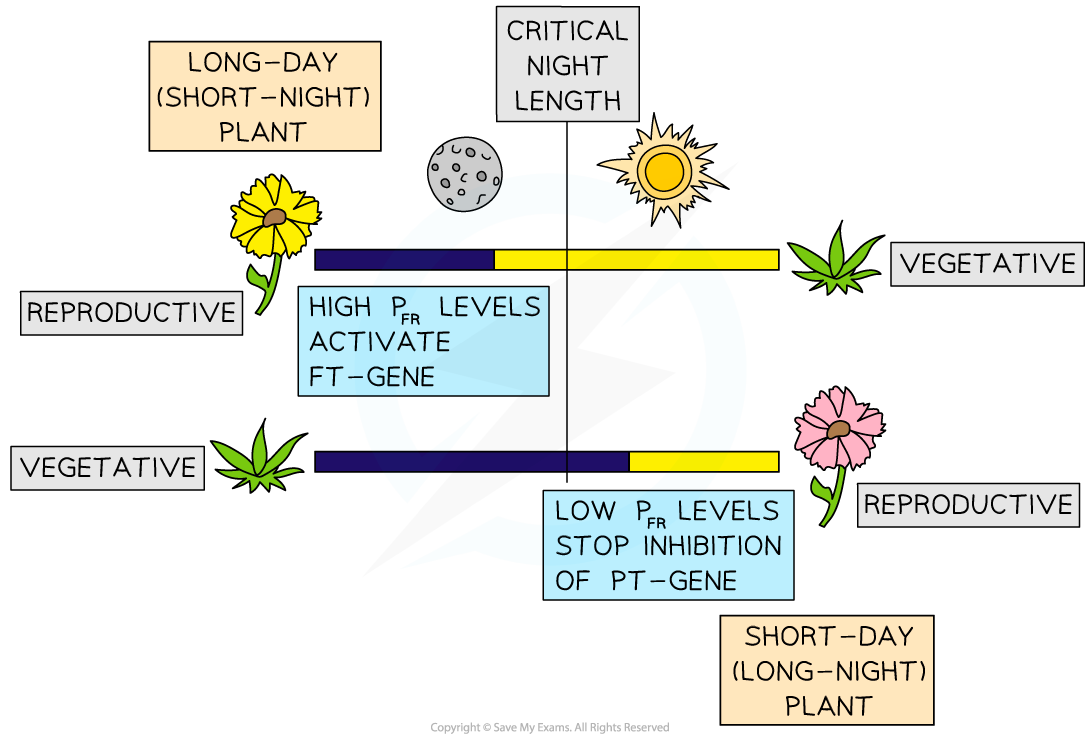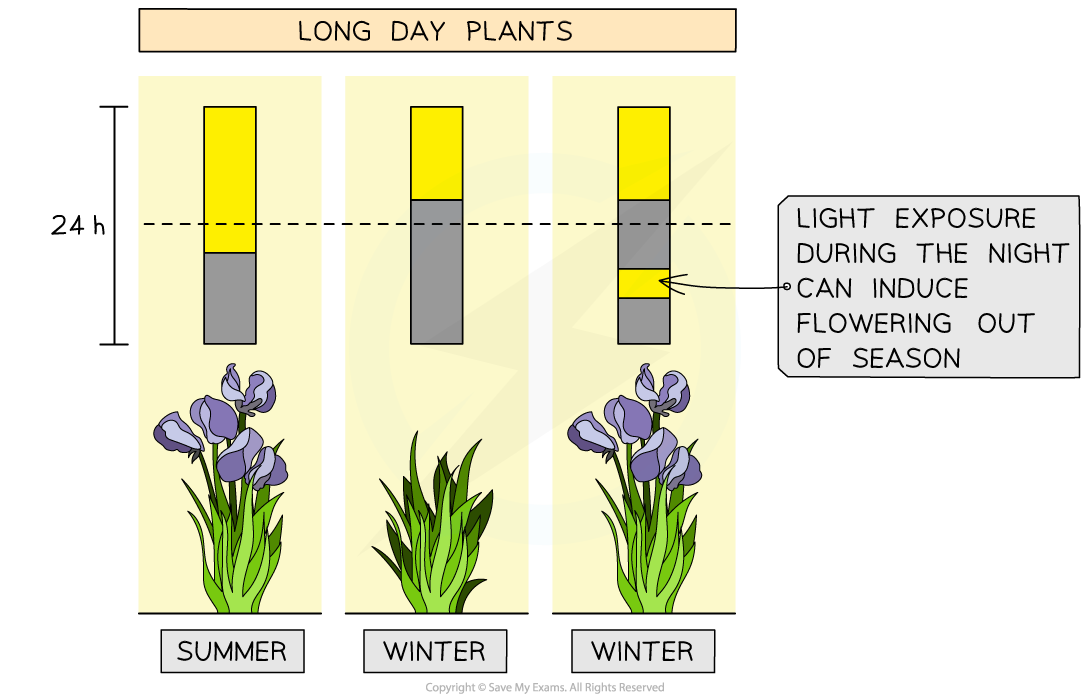Flowering & Gene Expression
- The life cycle of a flowering plant involves
- The vegetative phase
- The part of the life cycle during which plant growth takes places
- A plant in the vegetative phase consists of roots, stems and leaves
- A plant in this phase can often reproduce asexually
- The reproductive phase
- The part of the life cycle when flowers are produced by the shoot apical meristems
- A plant in the reproductive phase can reproduce sexually
- The vegetative phase

A flowering plant alternates between vegetative and reproductive phases
- Sexual reproduction involves two parents and the fusion of two gametes
- In order for a plant to move from the vegetative phase to the reproductive stage, meristems in the shoot needs to be stimulated to produce a flower rather than a leaf
- This stimulation can be brought about by changes in certain abiotic factors such as temperature or night length which alter gene expression in the shoot apical meristem
Flowering & Photoperiods
- It has been shown that the controlling factor in flowering is the length of the night
- It was previously thought that day length was the controlling factor
- When the night reaches a certain critical length, genes that control flowering in the plant may be switched on or off, leading to the activation or inhibition of flowering
- Genes that are switched on are expressed, leading to production of the polypeptides for which they code, while genes that are switched off are not expressed, so the polypeptides for which they code are not produced
- This critical length is important as it determines the quantities of different forms of a pigment called phytochrome in the leaf
Phytochrome
- The phytochrome pigment exists in two forms
- PR is the inactive form of phytochrome, it absorbs light from the red part of the spectrum (wavelength 660 nm)
- PFR is the active form of phytochrome, it absorbs light from the far red part of the spectrum (wavelength 730 nm)

Two forms of phytochrome absorb light from different parts of the spectrum. Note that absorptance is the ratio of the total amount of light absorbed to the total amount falling on an object
- Absorption of different wavelengths of light causes a reversible conversion between the PR and PFR forms of phytochrome
- When PR absorbs red light (660 nm) it is converted into PFR
- When PFR absorbs far red light (730 nm) it is converted back into PR
- In the absence of red light the unstable PFR gradually converts back into PR
- During the day levels of PFR rise
- Sunlight contains more wavelengths at 660 nm than 730 so the conversion from PR to PFR occurs more rapidly in the daytime than the conversion from PFR to PR
- During the night levels of PR rise
- Red light wavelengths are not available in the darkness and PFR converts slowly back to PR

PR is converted to PFR in a reversible reaction which controls flowering
Long day plants
- Long day plants flower when the nights are shorter than the critical length e.g in summer
- When nights are short, the day length is longer, hence the term 'long day plants'
- In long day plants, high levels of the active form of phytochrome activate flowering
- Flowering occurs due to the following process
- Days are long so PR is converted to PFR at a greater rate than PFR is converted to PR
- The active form of phytochrome, PFR, is present at high levels
- High levels of PFR activate flowering
- PFR binds to receptors in the cytoplasm of the leaf cells, activating expression of the flowering time (FT) gene
- The active gene is transcribed and translated in the shoot apex
- The resulting protein binds to a transcription factor which leads to the expression of multiple genes associated with flowering and converts the meristem from vegetative to reproductive
Short day plants
- Short day plants flower when the nights are longer than the critical length e.g. autumn
- When nights are long, the day length is shorter, hence the term 'short day plants'
- In short day plants, high levels of the active form of phytochrome inhibit flowering
- Note that this is the opposite effect to that of high levels of PFR in long day plants
- Flowering occurs due to the following process
- PFR inhibits flowering in short day plants when it is present at high enough levels
- PFR binds to receptors in the cytoplasm of the leaf cells and inhibits transcription and translation of the flowering time (FT) gene
- Long nights lead to low levels of PFR due to the slow conversion of PR back into PFR in the absence of red light
- When PFR levels are low, there is no inhibition of flowering as the FT gene can be transcribed and translated
- The resulting protein binds to a transcription factor which leads to the expression of multiple genes associated with flowering and converts the meristem from vegetative to reproductive
- PFR inhibits flowering in short day plants when it is present at high enough levels

Long day plants flower when PFR levels are high and short day plants flower when PFR levels are low.
Exam Tip
Plants can be confusing as plant substances don't always have a consistent effect on plant growth! Here you need to remember that a high level of PFR activates flowering in long day plants, and inhibits flowering in short day plants.
Inducing Flowering Out of Season
- Normal flowering times in plants require the critical dark period to be uninterrupted
- Sometimes it might be necessary to induce flowering at times when plants would normally be in their vegetative state
- For example, growers of flowers which are sold as cut flowers can provide flowers out of season through manipulation of night length
- Flowering in short day plants can be induced during the longer day season, such as during the summer, by providing a longer dark period e.g. by covering plants up
- Flowering in long day plants can be induced during the winter months when days are short, by providing periods of light during the night time

Long-day plants can be induced to flower out of season through providing additional light
